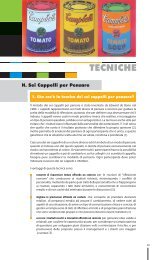Creativity Theory - TRaining MAterial in Creativity and InnovaTion ...
Creativity Theory - TRaining MAterial in Creativity and InnovaTion ...
Creativity Theory - TRaining MAterial in Creativity and InnovaTion ...
You also want an ePaper? Increase the reach of your titles
YUMPU automatically turns print PDFs into web optimized ePapers that Google loves.
28<br />
A. ESSENTIALS<br />
derst<strong>and</strong> creativity <strong>in</strong> a social context necessitates an exploration of creative<br />
processes, creative products, creative persons <strong>and</strong> creative situations. A useful<br />
theory of organizational creativity must provide a framework of sufficient<br />
complexity <strong>and</strong> richness to <strong>in</strong>tegrate these four creative components.<br />
6. Characteristics of <strong>Creativity</strong><br />
People differ <strong>in</strong> their level of creativity as well as <strong>in</strong> the manner <strong>in</strong> which they express their<br />
creativity. Micheal Kirton [11] suggests that there are two types of creative persons: Adaptors,<br />
whose preference is to work with<strong>in</strong> the system to improve th<strong>in</strong>gs, <strong>and</strong> Innovators<br />
who ignore or challenge the system <strong>and</strong> come up with more radical proposals for change.<br />
Adaptors are conform<strong>in</strong>g, efficient <strong>and</strong> like to deal with ideas a few at a time, while Innovators<br />
are non-conform<strong>in</strong>g, <strong>in</strong>efficient, <strong>and</strong> like to propagate ideas. The Adaptor’s motive is<br />
towards do<strong>in</strong>g th<strong>in</strong>gs better, whereas the Innovator’s is towards do<strong>in</strong>g th<strong>in</strong>gs differently.<br />
Adaptors Innovators<br />
Prefer to do th<strong>in</strong>gs better;<br />
Seek professions that encourage stability <strong>and</strong><br />
order such as accountability <strong>and</strong> production;<br />
Formulate ideas without chang<strong>in</strong>g the <strong>in</strong>itial data<br />
of the problem very much.<br />
Prefer to do th<strong>in</strong>gs differently;<br />
Are found <strong>in</strong> departments such as market<strong>in</strong>g<br />
which dem<strong>and</strong> <strong>in</strong>teraction with chang<strong>in</strong>g<br />
environments (who deal with uncerta<strong>in</strong>ty);<br />
Would rather produce ideas by <strong>in</strong>troduc<strong>in</strong>g new<br />
elements <strong>in</strong> the context of a problem <strong>and</strong> also by<br />
chang<strong>in</strong>g the relationship between the elements<br />
of a problem.<br />
Table 01: Differences between Adaptors <strong>and</strong> Innovators (Source of table: http://www.bra<strong>in</strong>storm<strong>in</strong>g.co.uk/contents.html)<br />
Despite this assumption we have to underl<strong>in</strong>e the ma<strong>in</strong> characteristics of creativity:<br />
Motivation is the measure of the emotional <strong>in</strong>vestment it takes for people to break<br />
natural <strong>in</strong>ertia <strong>and</strong> to move from their current circumstances toward what they want.<br />
The distance between circumstances <strong>and</strong> desire, creates emotional pressure that<br />
activates somebody to make someth<strong>in</strong>g new. This activat<strong>in</strong>g desire is the dynamics<br />
that starts a person on the creative process. In other words, to beg<strong>in</strong> a creative process,<br />
every <strong>in</strong>dividual <strong>and</strong> every company needs motivation. Once you are motivated,<br />
your curiosity follows <strong>and</strong> along with it comes fear. Curiosity consists of a search for<br />
possibly useful <strong>in</strong>formation <strong>and</strong> transforms the unknown from someth<strong>in</strong>g potentially<br />
dangerous <strong>in</strong>to someth<strong>in</strong>g manageable, <strong>in</strong>terest<strong>in</strong>g <strong>and</strong> beneficial. However, such an<br />
unknown is often frighten<strong>in</strong>g. In moments of fear, curiosity becomes hard to susta<strong>in</strong><br />
<strong>and</strong> so, some <strong>in</strong>dividuals, if sufficiently frightened, lose most of their capacity for creative<br />
curiosity. Furthermore, if faced with new potentially risky tasks they tend to avoid<br />
beg<strong>in</strong>n<strong>in</strong>g them. The solution could lie <strong>in</strong> an <strong>in</strong>dividual hav<strong>in</strong>g such strong <strong>in</strong>tr<strong>in</strong>sic<br />
belief <strong>and</strong> commitment to the work that any possible discouragement is negated.<br />
Break<strong>in</strong>g <strong>and</strong> mak<strong>in</strong>g connections is where most of the work of creativity gets done.<br />
Destruction means destruction of rigid sets of assumptions about what can <strong>and</strong> can<br />
not be done <strong>in</strong> a particular situation. In relation to connections, most day-to-day creativity<br />
occurs when people have over time, ga<strong>in</strong>ed large amounts of <strong>in</strong>terconnected<br />
knowledge <strong>in</strong> select areas. But if it is true that people are more creatively prolific <strong>in</strong><br />
their particular discipl<strong>in</strong>e, it is also true that this could often be a h<strong>in</strong>drance to discovery.<br />
Look<strong>in</strong>g at patterns of <strong>in</strong>formation from different discipl<strong>in</strong>es helps break up current<br />
l<strong>in</strong>es of th<strong>in</strong>k<strong>in</strong>g <strong>and</strong> old assumptions. It is a useful way to start new connections.



